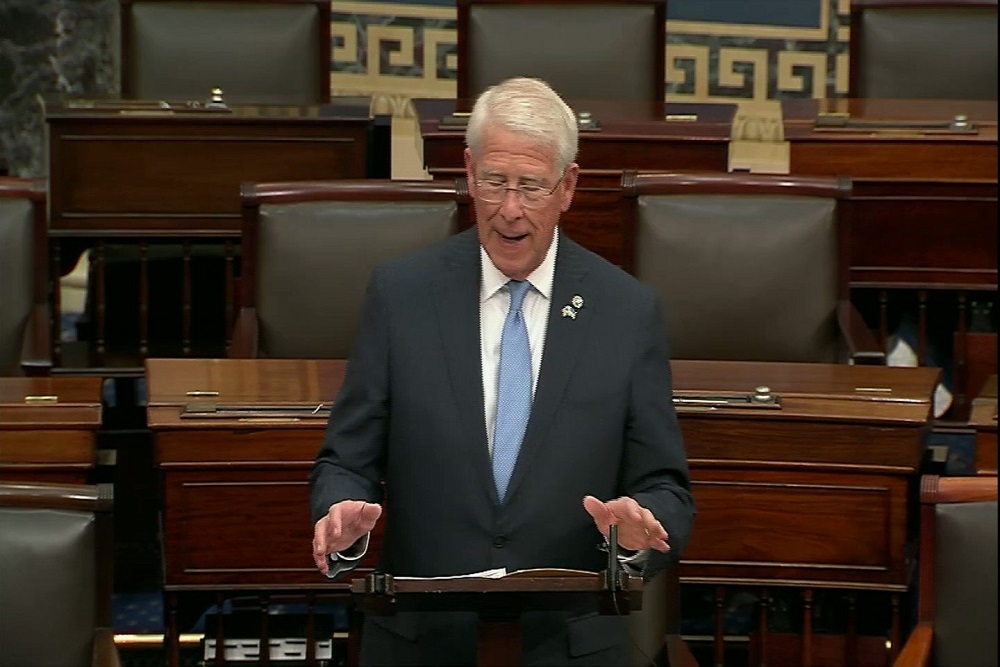U.S. Representatives Cathy McMorris Rodgers, R-WA, ranking member of the House Committee on Energy and Commerce, and Robert Latta, R-OH, ranking member of the Subcommittee on Communications and Technology, along with U.S. Senators Roger Wicker, R-MS, ranking member of the Senate Committee on Commerce, Science, and Transportation, and John Thune, R-SD, ranking member of the Subcommittee on Communications, Media, and Broadband, today sent a letter to Assistant Secretary of Commerce for Communications and Information Alan Davidson naming their priorities for implementation of the National Telecommunications and Information Administration’s (NTIA’s) Infrastructure and Jobs Act (IIJA) broadband programs.
The legislators call on the NTIA to:
Commit to using the FCC’s new broadband maps, once challenges are resolved, for the Broadband Equity, Access, and Deployment program and not rely on other data sources to supplement or substitute these maps;
Follow the IIJA’s directions on eligible project areas to avoid overbuilding;
Provide an equal opportunity for all broadband providers to compete for grants by not prioritizing municipal networks or networks run by nonprofits or cooperatives, and not favoring certain broadband technologies over others;
Avoid unnecessary requirements, such as net neutrality, burdensome labor regulations, and rate regulation;
Commit to transparency by allowing the public to provide input and review how the agency arrives at its decisions.
The legislators seek to ensure the money distributed will go to unserved and underserved communities, and protect against waste, fraud, and abuse.
Read the letter here or below.
Dear Assistant Secretary Davidson,
The United States faces a persistent digital divide. Millions of Americans continue to lack access to high-speed broadband and are unable to participate in the digital economy. To attempt to address this problem, Congress provided $65 billion in funding for broadband as part of the Infrastructure Investment and Jobs Act (IIJA). The National Telecommunications and Information Administration (NTIA) is responsible for administering $48.2 billion of this money. Of this amount, $42.45 billion is for the Broadband Equity, Access, and Deployment (BEAD) program, which will provide states grant money to award providers to deploy broadband networks in unserved areas. The other programs are intended to expand broadband deployment on Tribal lands, promote digital equity, and help develop middle-mile networks.
The IIJA included provisions requiring the use of accurate maps, preventing overbuilding, and prohibiting rate regulation and other unnecessary and burdensome requirements on providers receiving funds. We write to share our priorities for how NTIA should implement and further strengthen the integrity of these programs.
Commit to Using Federal Communications Commission’s Broadband Maps
The IIJA requires NTIA to use the Federal Communications Commission’s (FCC) new broadband maps, when they are available, to determine whether a location is unserved or underserved and therefore eligible for funding from the BEAD program. NTIA should not award funds until the FCC’s broadband maps are completed, with challenges adjudicated. The FCC’s challenge process permits any member of the public to challenge whether an area is served, and includes a robust process for verifying and resolving those challenges to ensure accuracy. Awarding money before the FCC resolves challenges could undermine the success of this program.
NTIA should also require eligible entities to use only the FCC’s maps when determining eligibility, as they are being developed though a rigorous process that Congress required to include specific standardization, verification, validation, and challenge processes. The same cannot be said of other data sources. Indeed, some agencies have even used subjective sources, including interviews, speed tests, and “any other information they deem relevant” when determining whether to fund a broadband project. Given the significant funding for the BEAD program, NTIA must not squander this important opportunity by using inaccurate data, which could lead to wasting funds and not closing the digital divide. NTIA therefore should not use other maps or data as a substitute for the FCC’s new maps when administering this program.
Pursuant to the IIJA, NTIA should also require that a state administering a challenge process account for the rigorous challenge process required for the FCC’s new maps under the Broadband DATA Act.[1] As discussed, the FCC’s challenge process already ensures accuracy. Thus, any discrepancy found by a state challenge should be resolved using the
same rigorous process used by the FCC.
Follow the IIJA’s Directions on Eligible Project Areas to Avoid Overbuilding
NTIA should not deviate from the IIJA’s explicit instructions for determining areas eligible for BEAD funding. As required by the law, NTIA should first fund unserved areas, defined as areas where 80 percent of locations lack reliable broadband access at speeds not less than 25 Mbps download/3 Mbps upload, and then move to underserved areas, those where 80 percent of locations lack reliable broadband access at speeds not less than 100 Mbps/20 Mbps. Additionally, NTIA has authority to define Priority Broadband Projects. NTIA should use this discretion to prioritize projects in areas where 100 percent of locations lack reliable broadband access at speeds less than 25 Mbps/3 Mbps. Altering the prioritization of projects or the speed threshold, or considering other factors, like “an identified need for additional broadband infrastructure investment,” risks overbuilding existing networks, and leaving unserved and underserved communities without connectivity. Such actions would further exacerbate the digital divide and waste taxpayer dollars. This previously occurred with NTIA’s Broadband Technology Opportunities Program, which misused billions of dollars, overbuilt existing networks, and did little to close the digital divide. We cannot afford to repeat this mistake.
Equal Opportunity for Providers
NTIA should direct states to consider a variety of broadband providers when making their awards, provided they meet the criteria for program participation and awards. Other federal broadband programs, such as those run by the Department of Agriculture and the Department of the Treasury, have prioritized or favored applicants owned, operated by, or affiliated with local governments, nonprofits, or cooperatives. NTIA should not follow their lead. Favoring certain providers over others inhibits fair competition and puts the federal government in the position of picking winners and losers. Additionally, some of these entities have shown that they are not capable of this task. Rather than favoring entities with little or no experience building costly and complex networks, NTIA should focus on funding those with proven track records of successful deployments in a cost-effective manner. NTIA should also resist the temptation to favor certain technologies over others. The program should consider all technologies that can meet the IIJA’s network requirements at a reasonable cost. A technology-inclusive approach will maximize the impact of the funding and efficiently connect more Americans faster.
No Unnecessary Requirements or Rate Regulation
NTIA will need to impose certain requirements on the broadband providers that are awarded grants from states. Such requirements are necessary to ensure these providers have the financial and technical capacity to deliver on their obligations. But NTIA should refrain from adding additional, needless requirements that will increase the cost and challenges of deploying new networks. These include requiring broadband providers to commit to net neutrality restrictions, adopting burdensome labor standards, and favoring open-access networks. Such requirements are unnecessary, go beyond the scope of congressional intent, could raise the monthly cost of broadband service, and could discourage participation from providers, undermining the success of the BEAD program and harming consumers.
Instead, NTIA should work with states to reduce regulatory and permitting burdens that could undermine the effectiveness of the BEAD program. When considering the approval of an eligible entity’s final plan, NTIA is required to determine whether the use of funds “is in the public interest.” NTIA should use this opportunity to ensure that states are taking reasonable steps to reduce permitting barriers to broadband deployment, such as charging higher than cost-based fees, lengthy delays, or duplicative approvals. It is critical that this funding be used to subsidize broadband deployment and not subsidize more red tape.
Affordability is also an important goal of these programs – the IIJA requires broadband providers that receive BEAD funding to offer a low-cost option. This requirement, in addition to subsidies provided by the FCC’s Affordable Connectivity Program, should be sufficient to ensure affordable broadband access for all Americans.
We remain concerned, however, by potential attempts to regulate broadband rates. The IIJA includes a provision barring NTIA from regulating broadband rates. That provision, however, does nothing to restrict states from regulating the rates themselves. NTIA should refrain from indirectly regulating rates by requiring that states regulate broadband rates as a condition of this program. Broadband rates vary within states for a variety of reasons, including terrain and population density. Requiring a one-size-fits-all rate, even within one state, would not account for these factors and could jeopardize the long-term sustainability of these investments. Additionally, NTIA should not abuse the discretion given to the Assistant Secretary to approve a provider’s low-cost option as a way to control rates. Additional intervention to regulate these options is unnecessary.
Transparency
The IIJA exempts the BEAD program from the Administrative Procedures Act (APA). In doing so, the law exempts NTIA from notice-and-comment rulemaking[2] and the Freedom of Information Act, two important statutory protections that ensure transparency in Executive Branch decision making. As a result, the public is left without a formal forum to provide input on the rules that will govern this important program, and without any insight into how NTIA makes decisions. We ask that, notwithstanding the IIJA’s APA exemption, NTIA administer the BEAD program with full transparency and allow the public to provide input and review how the agency arrives at its decisions.
NTIA should also work closely to collect information from other agencies awarding broadband funds and ensure it does not duplicate funding in those same areas. Over the past two years, Congress has created a number of programs spread across multiple agencies to support broadband deployment. Coordination among these agencies will ensure that this money is effectively and efficiently spent.
Closing the digital divide is a top priority of Congress, but this will only be achieved if NTIA carefully administers these programs and prioritizes unserved and underserved communities based on accurate data. NTIA cannot afford to repeat the mistakes of the past. We need to work together to ensure the BEAD program’s success.
Thank you for your attention to this important matter.






 Alerts Sign-up
Alerts Sign-up